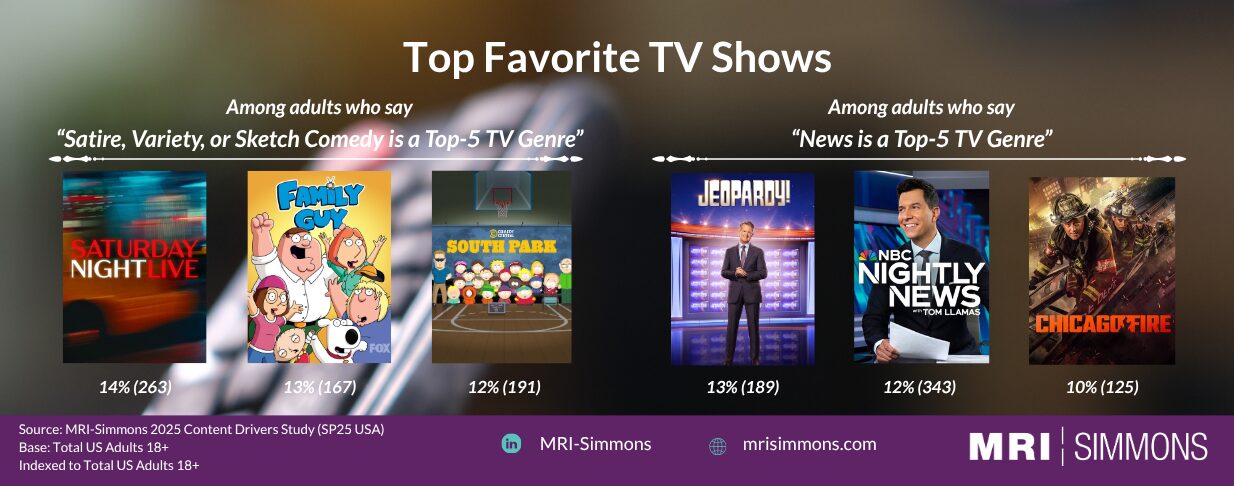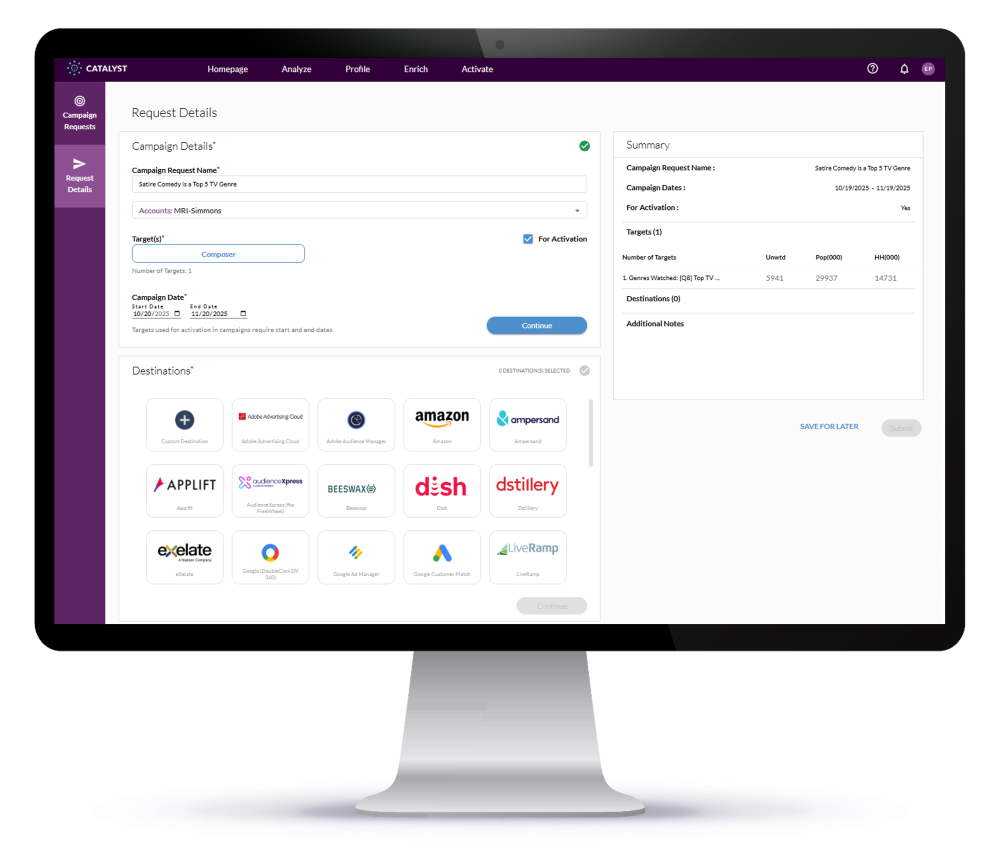Satire Surges, News Adapts: How Streaming Is Reshaping TV Genre Popularity
Streaming Is Now the Mainstage for All Generations
The way Americans watch TV has undergone a seismic shift. According to MRI-Simmons’ Content Drivers Study, 82% of US adults stream TV on their own schedule, up from 79% last year, while 56% watch live traditional TV, down from 61%. Free streaming services are gaining traction, with 42% of adults accessing them in the past year, up from 38%. Subscription TV network apps are also on the rise, with 37% of adults using them, up from 29%. All these trends reveal that streaming continues to grow as more services and apps are introduced to the space. Most notably, in 2025, streaming officially became the dominant go-to method of TV consumption across all generations. Going to a streaming service has been the top method of finding TV content for Gen Z and Millennials for years, but this year browsing streaming services beat out traditional channel surfing for Baby Boomers.
This shift in viewing habits is more than just a change in platform. Audiences are gravitating toward content that fits their lifestyle, mood, and values. As traditional TV declines, streaming platforms are redefining TV entertainment. And with this transformation comes a reshuffling of genre preferences, with satire and sketch comedy viewership rising 12 points over the past 5 years, while news audiences are narrowing.
Satire Is the New Prime Time: Young, Engaged, and Ready to Laugh
Satire and sketch comedy are having a moment. 32% of Americans now regularly watch satire, up from just 20% in 2020. That’s a jump of 12 percentage points in five years. Even more telling, 30 million Americans say satire is a top-5 genre for them, up from 23 million last year. These top-5 viewers skew younger, with a median age of 40, and 28% have kids at home, making them 16% more likely than the average adult to be raising children.
This audience is highly engaged and open-minded. 77% are open to watching reboots or remakes of old favorites, up from 71% last year. While 60% still crave news and knowledge-based content, that’s down from 66%, suggesting a shift toward entertainment over information. Interestingly, 35% don’t like to admit the types of shows they watch, down from 44%, indicating growing confidence in their viewing choices.
What motivates these viewers? They’re 64% more likely than the average adult to enjoy seeing characters in embarrassing situations, 60% more likely to seek satirical humor, and 59% more likely to be drawn to trashy or bad characters. They’re also 36% more likely to buy TV merchandise and 23% more likely to find TV ads just as entertaining as the content itself. Their favorite shows include Saturday Night Live (14%), Family Guy (13%), and South Park (12%), with a notable 113% higher likelihood of naming Impractical Jokers as a top show.
From a marketing perspective, this group is gold. They’re 19% more likely to be influenced by social media influencers, 17% more likely to buy products used by celebrities, and 15% more likely to be early adopters among friends. They’re also 15% more likely to buy products advertised on their favorite networks or streaming services. In short, satire fans are not just watching to laugh. They’re watching to find out what they need to buy.

News Programming Navigates Shifts, But Opportunities for Reinvention Are Strong
While the TV landscape is shifting, news programming remains a vital part of the media ecosystem. Today, 31% of Americans regularly watch news, down from 44% five years ago, and 14% say it’s a top-5 genre, compared to 24% in 2020. These top-5 viewers tend to be older (median age of 64), predominantly male (61%), and mostly white (nearly 80%). Though the audience is narrowing, it remains deeply loyal, being 12% more likely than average to have favorite networks they always watch.
Importantly, this group is still highly motivated by informative content. They’re 144% more likely than average to seek programming that keeps them up to date, 57% more likely to want educational content, and 30% more likely to watch shows that reflect their values. Their top shows are Jeopardy (13%), NBC Nightly News (12%), and Chicago Fire (10%), highlighting a preference for trusted formats and familiar storytelling. They’re also 269% more likely to name Hannity as a favorite, showing strong brand affinity.
However, the desire for news and knowledge-based content has softened recently not just among top news viewers, but for all TV viewers. Between 2022 and 2024, interest grew, but in 2025, over 8 million TV viewers moved away from craving news content. This shift could be caused by an increase in devastating news stories, the current political landscape in the US, or simply that Americans are craving more laughter in their day-to-day. Either way, this presents an opportunity. News outlets can evolve by embracing new formats, integrating more interactive and streaming-friendly experiences, and expanding their appeal to younger audiences. For example, blending factual reporting with engaging (and possibly humorous) storytelling or leveraging social media influencers could help bridge generational gaps.
Top news viewers are 15% more likely to need help with new technology, suggesting that approaches like simplified streaming access or curated news apps could improve reach. They’re also 12% more likely to feel financially secure, making them a valuable audience for premium content and brand partnerships. In short, while the numbers show a decline, the loyalty and trust this audience places in news programming is a strong foundation. With the right innovations, news outlets can not only retain their core viewers but also attract new ones in today’s dynamic media environment.
A Shifting TV Landscape and a Call to Innovate Across All Genres
The TV landscape is evolving rapidly, driven by the rise of streaming and changing viewer preferences. Satire and sketch comedy are capturing the attention of younger, more digitally engaged audiences who are eager for humor, relatability, and fresh formats. At the same time, news programming (while facing a decline in regular viewership) is still deeply valued by a loyal and informed audience. These shifts don’t signal the end of any genre, but rather a call for reinvention.
For advertisers and media companies, the message is clear: adaptability is key. Satire fans are highly responsive to creative advertising and influencer-driven campaigns, making them ideal targets for innovative brand storytelling. Meanwhile, news outlets have a unique opportunity to modernize their delivery, expand into streaming and social platforms, and engage younger viewers without compromising journalistic integrity.
The future of TV is not about choosing one genre over another. It’s about understanding the nuances of each audience and meeting them where they are. Whether it’s through humor, information, or emotional connection, content that resonates will always find its place. Advertisers who embrace this complexity and tailor their strategies accordingly will be best positioned to thrive.
Sources: 2025 Content Drivers Study (SP25 USA). Base: Total US adults 18+.
Activating TV Viewers through MRI-Simmons
Through MRI-Simmons' activation solution, ACT, marketers can leverage trusted and nationally representative data to target and reach satire TV viewers, news TV viewers, FAST viewers, those who think ads are entertaining, or any other target. Curate your audience with over 60,000 consumer elements: 1000+ attitudes and opinions, 6500+ brands in 1000+ product categories; and 90+ proprietary segments. Then, activate your audience via the ad-tech platform or media partner of your choice.





